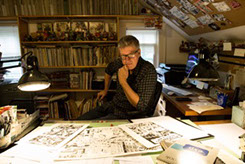John "Derf" Backderf
2018 MID-CAREER ARTIST PRIZE IN VISUAL ARTS
From a child growing up in Richfield, OH, scrawling on piles of scrap paper his father brought home from his BF Goodrich lab, to an internationally known cartoonist and graphic novelist, Derf has experienced a lifelong artistic trajectory.

“I don’t remember a time when I wasn’t interested in comics,” he declares. “Newspaper comics first, and then a progression of Mad Magazine and comic books, so it’s always been there.” Early inspirations were cartoonists Charles Schultz, Harvey Kurtzman and Jack Kirby, but they did not directly influence his work.
By the 1980s, Derf had dropped out of art school; toiled as a garbage man, attended The Ohio State University’s now-defunct journalism school on a scholarship, drew controversial political cartoons for The Lantern and earned his BA in Journalism in 1978; and gone on to work for newspapers in South Florida before he and his wife, fellow journalist Sheryl Harris, returned to Cleveland.
Unhappy with the work he was doing as a cartoonist for The Plain Dealer, he quit and scrapped everything he was doing. “I decided I’m not going write or draw like this anymore, and just holed up for a year,” he recalls.
During that time, Derf immersed himself in Cleveland’s counter culture, hanging out, people watching and drawing or storing images in his mind of the colorful characters at Arabica Coffee on Coventry and a coffee shop on the first floor of the Old Arcade or at venues such as the Phantasy Nightclub and Peabody’s or at some of the old diners such as Ruthie & Moe’s, the Big Egg, Otto Mosers and the Detroiter.
“I took in everything,” he says. “Definitely the city itself, and I just kind of shoved it though this filter, and what came out was me.”
Derf rolled out his now iconic style when the comic strip The City debuted in the Cleveland Edition in 1990, and a year later he began selling it to other alternative papers. During its 20-plus years, the strip appeared in more than 140 publications, including The Village Voice, Chicago Reader and The Los Angeles Reader. He retired The City in 2013 so that he could concentrate on books.
By the late ‘90s, he began to sense the oncoming struggle of weekly newspapers losing ad revenue to online competition. “I figured I’d better have a Plan B,” he says. “So I started working on longer-form work at that point, and it took a long time before I finally produced something.”
He began to write and draw graphic short stories and then published the Punk Rock & Trailer Parks graphic novel in 2009. In 2012, his “big breakthrough work” was My Friend Dahmer, a graphic novel about Derf's junior high and high school friendship with future serial killer Jeffrey Dahmer, which he had started developing in 1991.
He’s achieved the most success from his graphic novels, which have been translated into 12 languages. My Friend Dahmer was adapted into a successful film, and Trashed is currently in production.
“It’s cool and was very unexpected,” Derf comments about the worldwide popularity, particularly in France, of his novels published by one of the largest publishers in the US, Abrams, which is owned by the world’s largest publisher, Hachette Book Group. “What I’ve found is that Europeans are really fascinated with Ohio, or at least my Ohio and the whole concept of the Rust Belt.”
The controversial cartoonist has won more than 50 awards for his newspaper work. He was a member of the newsroom team for the Akron Beacon Journal that was awarded the Pulitzer Prize in 1995. His work has been displayed in museums and galleries worldwide. He has been nominated for three Eisner Awards (the Oscars of comix) and won one for Trashed, as well as Harvey, Ignatz and Rueben Awards. In 2006, he received a prestigious Robert F. Kennedy Journalism Award for political cartoons and an Angoulême Prize for My Friend Dahmer in 2014.
Established in 2011, the Derf Collection, comprised of three decades of original art and papers, is part of the Billy Ireland Cartoon Museum at his alma mater. “Derf’s renderings of humanity are alternately beautiful and grotesque, but consistently honest, clean, poignant and jarring,” says Caitlin McGurk, associate curator. “The museum could not be happier to preserve his work for future generations of scholars and fans.”
Currently, Derf’s putting in the long, intricate hours hunched over his drawing table, penciling, inking and writing two new graphic novels and plans to continue chronicling the bizarre characters and underground milieu of Ohio. “When you write what you know it infuses your work with an element of truth that people respond to,” he says. “That’s not to say I will always write about Ohio, but for now, I find a lot of stories here to tell, so that’s all that counts.”
Cleveland Arts Prize
P.O. Box 21126 • Cleveland, OH 44121 • 440-523-9889 • info@clevelandartsprize.org